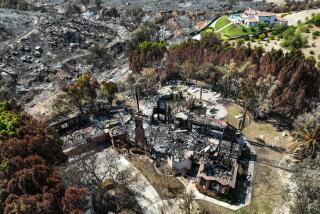More Bad News for Hughes : Pentagon Auditor Agrees That Company Overcharged on B-2
The top Pentagon auditor at Hughes Aircraft has asserted that the aerospace company overcharged the Air Force on development of the B-2 bomber’s radar system, concurring with allegations raised in a major lawsuit brought by a Hughes executive, according to an internal government memorandum.
The memo, which was prepared in March for the national director of the Defense Contract Audit Agency, also disclosed that the House Armed Services Committee has initiated an investigation into the alleged overcharging on the B-2 bomber’s radar. A congressional investigator said Wednesday that the committee began an inquiry this year after learning of the controversy.
The Air Force is withholding $15 million from Hughes for allegedly overcharging on the B-2 radar by secretly spreading costs between that program and other radar programs at the firm’s Radar Systems Group in El Segundo. Northrop is the prime contractor on the B-2.
Attorneys for Hughes Aircraft denied Wednesday that the company had overcharged the Air Force. They said the audit agency erred in its findings because it misunderstood specific facts in the radar case. Hughes is seeking to recover the $15 million, they added.
Nonetheless, the memo’s assertions come at a time in which the $64.8-billion bomber program is reeling from Congressional concerns over whether it can perform up to Air Force requirements. The additional controversy over the radar could add to the political obstacles already facing the program.
The memo, written by Hughes resident auditor Jeffrey L. McGowan, discloses that the audit agency issued a finding of “suspected irregularity” in October, 1986, in which Hughes was accused of overcharging the government by $29 million. The finding, known in government procurement as a Form 2000, was sent to the Department of Justice as well as the Air Force’s Office of Special Investigations, but no formal action was taken.
Then, in 1989, William Schumer, the Hughes contracting executive responsible for the B-2 radar, filed a whistle-blower lawsuit.
He alleged that Hughes had secretly and illegally decided to share costs between four radar programs--in effect shifting some costs from fixed-price contracts for fighter radars to a cost-plus contract on the B-2 bomber. Under a fixed-price contract, a defense firm bears the liability of any cost overrun, while on a cost-plus agreement the government pays for overruns.
Schumer alleged that Hughes had secretly created an internal “commonality agreement,” in which the program managers of the radar group had decided to spread the cost of technology among the radars for the F-14, F-15, F-18 and B-2. The agreement was ordered in July, 1983, by the then-president of the radar systems group, J. R. Giacoletto, according to the suit.
James J. Gallagher, an attorney at the law firm McKenna & Cuneo, which represents Hughes, said that electronics technology developed for the B-2 was also used by the F-15 and that Hughes properly allocated costs about equally to the two programs. Hughes eventually lost money on the fixed-price contract for the F-15, he said.
The Department of Justice reviewed Schumer’s allegations and declined to join the suit, which was brought under the federal False Claims Act. But Schumer is continuing to press the case and recently retained a new attorney, Herbert Hafif.
Schumer, who holds a law degree, refused to draft the commonality agreement, arguing that it would be illegal, the suit asserts. In September, 1983, “Giacoletto summoned Schumer into his office and demanded to see what Schumer had done on the commonality agreement. Schumer reported that he had done nothing to create the agreement and joked, ‘Tell me where they send you so I can have my wife bake a cake with a file in it,’ ” a disclosure statement by Schumer attached to the civil complaint said. “Giacoletto became angry and said, ‘Damn it. I am directing you to draw up that agreement.’ ”
The commonality agreement that was eventually drafted was done by another Hughes employee. Schumer was later demoted and transferred to another Hughes group, where he remains employed. A separate wrongful termination claim brought by Schumer against Hughes was dismissed in 1989.
The audit agency concluded in the memo that Hughes had no “contractual” basis for spreading the costs between radar programs. The memo also states that the allegation made by Schumer “has merit.”
But Gallagher argued that the company’s actions were permitted under government cost accounting regulations. He added that the Air Force encouraged the company to use common technology in radar programs as part of an effort to save money.
In order to recover the $15 million withheld by the government, Northrop must submit a claim to the Air Force on Hughes’ behalf. Hughes briefed Northrop on the matter two months ago, but so far Northrop officials have not signed the claim document, Gallagher said. But he asserted that Northrop supports the Hughes position.
Hughes could be liable for three times the $29 million in overcharges identified by the auditors, if Schumer is successful in his lawsuit. Also, Hughes could be liable for more than $5 million in civil penalties, Hafif said.
The B-2 bomber’s radar is among the most sophisticated and expensive in the history of aerospace. The radar program is costing $2.4 billion for development and production of radar sets for 75 aircraft--meaning that the radars for each aircraft will run an average of $32 million.
More to Read
Inside the business of entertainment
The Wide Shot brings you news, analysis and insights on everything from streaming wars to production — and what it all means for the future.
You may occasionally receive promotional content from the Los Angeles Times.







